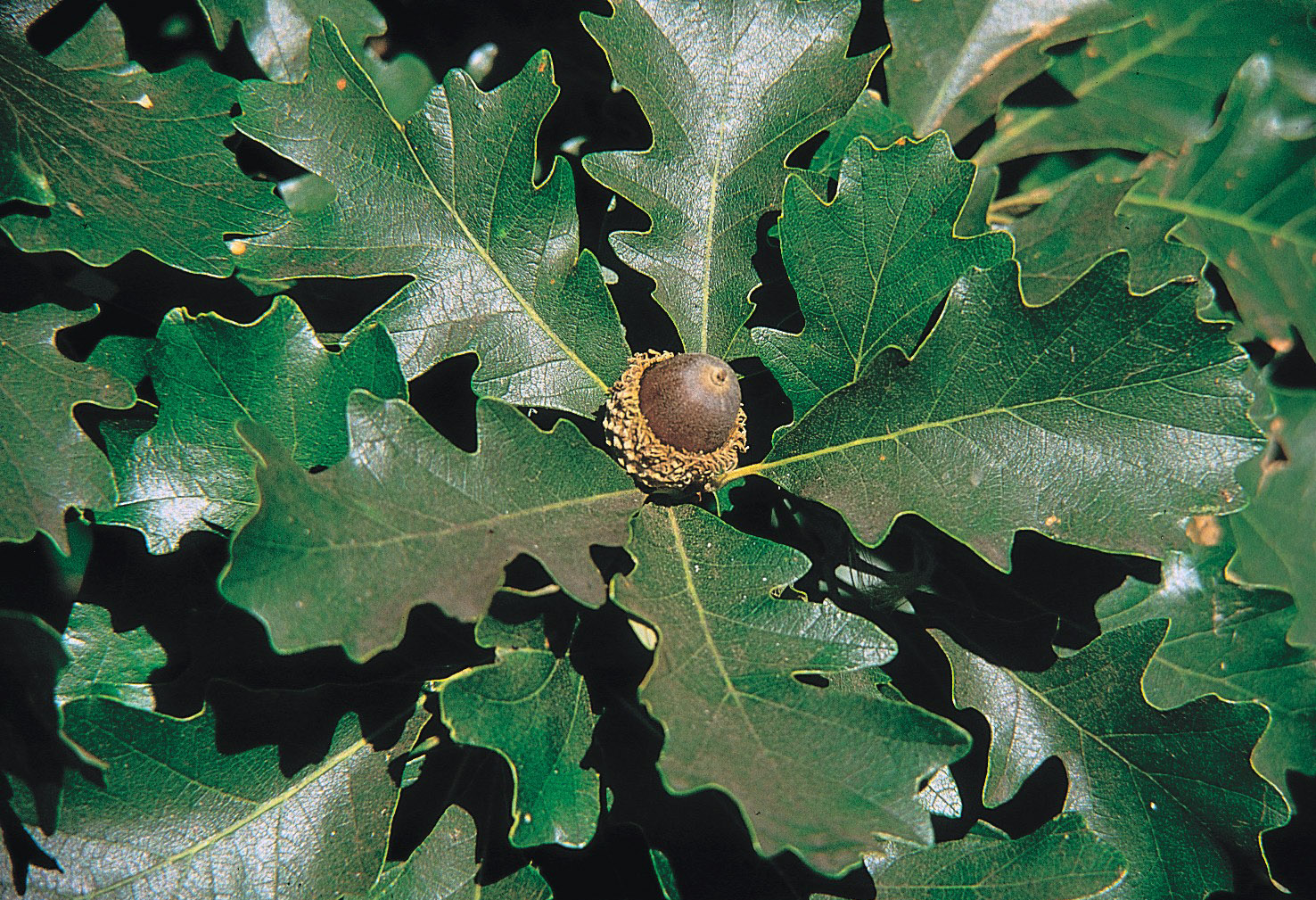- Bur oak
Taxobox
name = Bur Oak
status = LR/lc | status_system = IUCN2.3

image_width = 240px
image_caption = Bur Oak leaves and acorn
regnum =Plant ae
divisio = Magnoliophyta
classis = Magnoliopsida
ordo =Fagales
familia =Fagaceae
genus = "Quercus"
sectio = "Quercus"
species = "Q. macrocarpa"
binomial = "Quercus macrocarpa"
binomial_authority = Michx.The Bur Oak, ("Quercus macrocarpa"), sometimes spelled Burr Oak, is a species of
oak in the white oak section "Quercus" sect. "Quercus", native toNorth America in the eastern and midwesternUnited States and south-centralCanada . This plant is also called Mossycup oak and Mossycup white oak. It occurs from theAppalachian Mountains west to the middle of theGreat Plains , extending to centralTexas , across southernmostManitoba ,Ontario andQuebec , east to the Atlantic Coast in southernNew Brunswick , and down the coast toDelaware . Bur Oak is the state tree ofIowa .It is a large
deciduous tree growing up to 30 m (100 ft), rarely 37 m (120 ft), in height, and is one the most massive oaks with a trunk diameter of up to 3 m (10 ft); reports of taller trees occur, but have not been verified. It is one of slowest-growing oaks, withgrowth rate of 30 cm (1 ft) per year when young. A 20-year-old tree will be about 6 m (20 ft) tall. It commonly lives to be 200 to 300 years old, and may become significantly older. Thebark is a medium gray and somewhat rugged.The leaves are 7-15 cm (3-6 in) long and 5-13 cm (2-5 in) broad, variable in shape, with a lobed margin. Most often, the basal 60% is narrower and deeply lobed, while the apical 40% is wider and has shallow lobes or large teeth. The
flower s are greenish-yellowcatkin s, produced in the spring. Theacorn s are very large, 2-5 cm (0.8-2 in) long and 2-4 cm (0.8-1.5 in) broad, with a large cup that wraps much of the way around the nut, with large overlapping scales and often a fringe at the edge of the cup.Bur Oak is sometimes confused with
Overcup oak andWhite oak .Ecology
Bur Oak typically grows in the open, away from
forest canopy. For this reason, it is an important tree on the easternprairie s, where it is often found nearwaterway s in more forested areas, where there is a break in the canopy. It is also a fire-resistant tree, and possesses significantdrought resistance by virtue of a longtaproot . New trees may, after two to three years of growth, possess a 1-2 m deep taproot. TheWest Virginia state champion Bur Oak has atrunk diameter of almost 3 m (9 feet).The acorns are the largest of any North American oak, and are an important
wildlife food;American Black Bear s sometimes tear off branches to get them. However, heavy nut crops are borne only every few years. In this strategy, known as masting, the large seed crop every few years overwhelms the ability of seed predators to eat the acorns, thus ensuring the survival of some seeds. Other wildlife, such asdeer andporcupine , eat the leaves, twigs and bark.Cattle are heavy browsers in some areas. The bur oak is the only known foodplant of "Bucculatrix recognita "caterpillar s.Cultivation and uses
Bur oak makes an outstanding
ornamental tree . It is one of the most tolerant of urban conditions of the white oaks, and is one of the fastest-growing of the group. It has been planted in many places north to Anchorage,Alaska and as far south asEdinburg, Texas . It withstands chinook conditions atCalgary ,Alberta .The
wood is high quality, and is almost always marketed as "white oak".The name sometimes is spelled "burr oak", as for example in
Burr Oak State Park inOhio , the city ofBurr Oak, Kansas , the village ofBurr Oak, Michigan , and in the title "Burr Oaks" by poetRichard Eberhart .It is also less commonly called "burl oak," as in the Burl Oaks Country Club in
Mound, Minnesota , and theBurl-Oak Theatre Company inOakville, Ontario References
*
* [http://www.efloras.org/florataxon.aspx?flora_id=1&taxon_id=233501058 Flora of North America: "Quercus macrocarpa"]
* [http://plants.usda.gov/java/profile?symbol=QUMA2 USDA Plants Profile: "Quercus macrocarpa"]
* [http://www.cas.vanderbilt.edu/bioimages/species/frame/quma2.htm "Quercus macrocarpa" images at bioimages.vanderbilt.edu]
Wikimedia Foundation. 2010.
